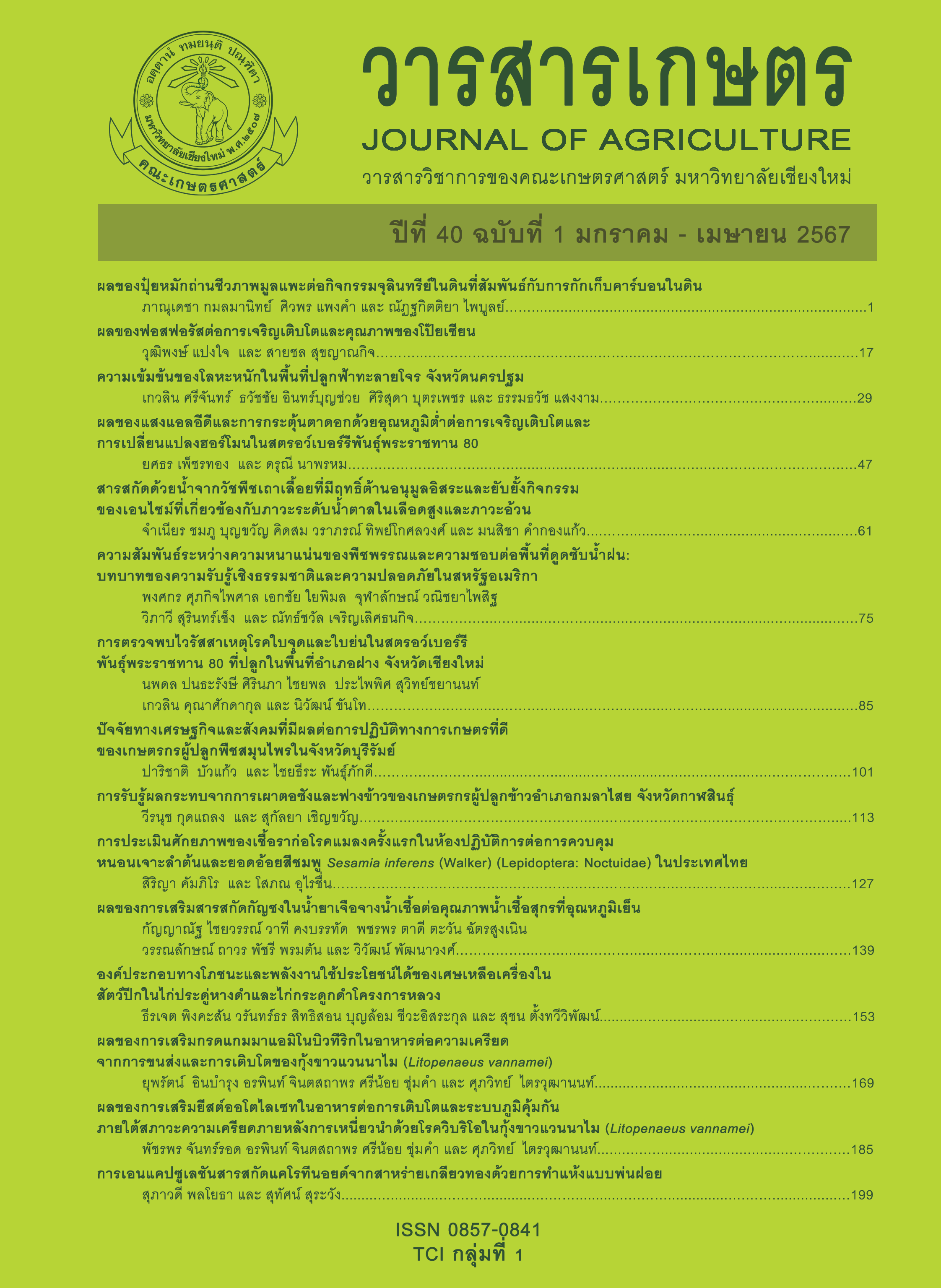ความสัมพันธ์ระหว่างความหนาแน่นของพืชพรรณและความชอบต่อพื้นที่ดูดซับน้ำฝน: บทบาทของความรับรู้เชิงธรรมชาติและความปลอดภัยในสหรัฐอเมริกา
Main Article Content
บทคัดย่อ
ในปัจจุบัน กลยุทธ์ในการจัดการสภาพแวดล้อมคือการแนะนำให้ใช้พืชและกระบวนการทางธรรมชาติในการจัดการน้ำท่วมขังและน้ำฝนที่ไหลบ่ามากยิ่งขึ้น หนึ่งในกลยุทธ์นั้นคือ การใช้พื้นที่ซับน้ำฝนทางชีวภาพ (bioretention) ซึ่งเริ่มมีการนำมาใช้ประโยชน์ในหลายประเทศแล้ว ในประเทศไทย เรื่องนี้เป็นเรื่องใหม่ ความเข้าใจในเรื่องของการรับรู้และการใช้ประโยชน์ของพื้นที่ซับน้ำฝนทางชีวภาพ ของผู้ออกแบบภูมิทัศน์ นักวางผัง และวิศวกร ยังมีอยู่น้อย ส่งผลต่อการยอมรับและการทำให้เกิดความยั่งยืนของการใช้พื้นที่ในลักษณะนี้ ได้มีรายงานถึงพื้นที่ภูมิทัศน์ที่มีจำนวนพืชพรรณในปริมาณที่มาก เป็นที่ยอมรับและชื่นชอบในทางบวก ในขณะที่กลไกที่จะอธิบายว่าทำไมมนุษย์ชอบพื้นที่ที่มีความหนาแน่นของพืชพรรณมากกว่าพื้นที่ที่มีความหนาแน่นของพืชพรรณน้อยกว่า ยังไม่ชัดเจน ผู้วิจัยจึงได้ออกแบบสอบถามความคิดเห็นกับบุคคลทั่วไป โดยใช้ภาพจำนวน 54 ภาพ หาความสัมพันธ์เปลี่ยนถ่าย (mediation) ระหว่างความหนาแน่นของพืชพรรณ การรับรู้ในความเป็นธรรมชาติและความปลอดภัย และความชอบในรูปแบบของพื้นที่ซับน้ำฝนทางชีวภาพ ผลการศึกษาพบว่า การรับรู้ในความเป็นธรรมชาติเป็นตัวแปรเปลี่ยนถ่ายที่มีอิทธิพลสูงระหว่างความหนาแน่นของพืชพรรณและความชอบ ในขณะที่การรับรู้ในความปลอดภัยเป็นตัวแปรเปลี่ยนถ่ายที่มีอิทธิพลต่ำ ผู้ออกแบบภูมิทัศน์ นักวางผัง และวิศวกร ควรใช้ความรู้นี้เป็นเครื่องมือในการประเมินการออกแบบพื้นที่ซับน้ำฝนชีวภาพ ผลที่ได้จากการศึกษาในครั้งนี้เป็นเรื่องใหม่ ที่ช่วยทำให้เข้าใจถึงการรับรู้ของมนุษย์ต่อการออกแบบภูมิทัศน์และสิ่งแวดล้อมในเชิงลึกมากยิ่งขึ้น ในอนาคต ควรวิจัยความสัมพันธ์ของความ-หลากหลายของพื้นที่ซับน้ำฝนชีวภาพ ความแตกต่างของวัฒนธรรมและเอกลักษณ์ของพื้นที่แต่ละแห่งต่อไป
Article Details

อนุญาตภายใต้เงื่อนไข Creative Commons Attribution-NonCommercial-NoDerivatives 4.0 International License.
เอกสารอ้างอิง
Baron, R.M. and D.A. Kenny. 1986. The moderator–mediator variable distinction in social psychological research: Conceptual, strategic, and statistical considerations. Journal of Personality and Social Psychology 51(6): 1173-1182.
Dassopoulos, A. and S.M. Monnat. 2011. Do perceptions of social cohesion, social support, and social control mediate the effects of local community participation on neighborhood satisfaction? Environment and Behavior 43(4): 546-565.
Jiang, B. 2013. Establishing dose-response curves for the impact of urban forests on recovery from acute stress and landscape preference. Ph.D. Dissertation. University of Illinois at Urbana-Champaign, Urbana, Illinois. 182 p.
Jiang, B., C.-Y. Chang and W.C. Sullivan. 2014a. A dose of nature: Tree cover, stress reduction, and gender differences. Landscape and Urban Planning 132: 26-36.
Jiang, B., D. Li, L. Larsen and W.C. Sullivan. 2014b. A dose-response curve describing the relationship between urban tree cover density and self-reported stress recovery. Environment and Behavior 48(4): 607-629.
Jiang, B., L. Larsen, B. Deal and W.C. Sullivan. 2015. A dose-response curve describing the relationship between tree cover density and landscape preference. Landscape and Urban Planning 139: 16-25.
Jiang, B., C.N.S. Mak, L. Larsen and H. Zhong. 2017. Minimizing the gender difference in perceived safety: Comparing the effects of urban back alley interventions. Journal of Environmental Psychology 51: 117-131.
Kaplan, S. 1995. The restorative benefits of nature: Toward an integrative framework. Journal of Environmental Psychology 15(3): 169-182.
Kellert, S.R. and E.O. Wilson. 1993. The Biophilia Hypothesis. Island Press, Washington, D.C. 484 p.
Kuo, F.E. and W.C. Sullivan. 2001. Environment and crime in the inner city: Does vegetation reduce crime? Environment and Behavior 33(3): 343-367.
Nassauer, J.I. 1995. Messy ecosystems, orderly frames. Landscape Journal 14(2): 161-170.
O'Brien, D.T., C. Farrell and B.C. Welsh. 2019. Broken (windows) theory: A meta-analysis of the evidence for the pathways from neighborhood disorder to resident health outcomes and behaviors. Social Science & Medicine 228: 272-292.
Padhy, S., G. Jansen, J. Alameda, E.F. Black, L. Diesendruck, M. Dietze, P. Kumar, R. Kooper, J. Lee, R. Liu., R. Marciano, L. Marini, D. Mattson, B. Minsker, C. Navarro, M. Slavenas, W. Sullivan, J. Votava, I. Zharnitsky, and K. McHenry. 2015. Brown Dog: Leveraging everything towards autocuration. pp. 493-500. In: Proceedings of 2015 IEEE International Conference on Big Data. IEEE, Santa Clara, CA.
Saengngern, S., N. Noosorn, T. Maton and C. Wanaratwichit. 2012. Factors predicting individual health promoting behaviors in older people living alone. Journal of Public Health 42(2): 68-81. (in Thai)
Sullivan, W.C., H. Frumkin, R.J. Jackson and C.-Y. Chang. 2014. Gaia meets Asclepius: Creating healthy places. Landscape and Urban Planning 127: 182-184.
Suppakittpaisarn, P. 2017. Green stormwater infrastructure, preference, and human well-being. Ph.D. Dissertation. University of Illinois at Urbana-Champaign, Urbana, Illinois. 150 p.
Suppakittpaisarn, P., L. Larsen and W.C. Sullivan. 2019a. Preferences for green infrastructure and green stormwater infrastructure in urban landscapes: Differences between designers and laypeople. Urban Forestry & Urban Greening 43: 126378, doi: 10.1016/j.ufug.
126378.
Suppakittpaisarn, P., X. Jiang and W.C. Sullivan. 2017. Green infrastructure, green stormwater infrastructure, and human health: A review. Current Landscape Ecology Reports 2(4): 96-110.
Suppakittpaisarn, P., B. Jiang, M. Slavenas and W.C. Sullivan. 2019b. Does density of green infrastructure predict preference? Urban Forestry & Urban Greening 40: 236-244.
Suppakittpaisarn, P., V. Surinseng, C. Wanitchayapaisit and E. Yaipimol. 2020a. Healthy ecosystem services and healthy human settlements: Opportunities and challenges in northern Thailand. Landscape Architecture 2020(9): 77-88.
Suppakittpaisarn, P., C.-Y. Chang, B. Deal, L. Larsen and W.C. Sullivan. 2020b. Does vegetation density and perceptions predict green stormwater infrastructure preference? Urban Forestry & Urban Greening 55: 126842, doi.10.1016/j.ufug.2020.126842.
Thompson, C.W. and P. Travlou. 2007. Open Space: People Space. Taylor and Francis, London. 199 p.
Ulrich, R.S. 1999. Effects of gardens on health outcomes: Theory and research. pp. 27-79. In: C.C. Marcus and M. Barnes (eds.). Healing Gardens: Therapeutic Benefits and Design Recommendations. John Wiley & Sons, New York.
USEPA. 2008. Managing Wet Weather with Green Infrastructure: Action Strategy. USEPA, Washington, D.C. 29 p.
Yaipimol, E., P. Suppakittpaisarn, C. Wanitchayapaisit, N. Charoenlertthanakit and V. Surinseng. 2022. Is 1-Minute of nature enough? Presence and durations of nature view during walking and attention restoration. BUILT 19: 51-61.


